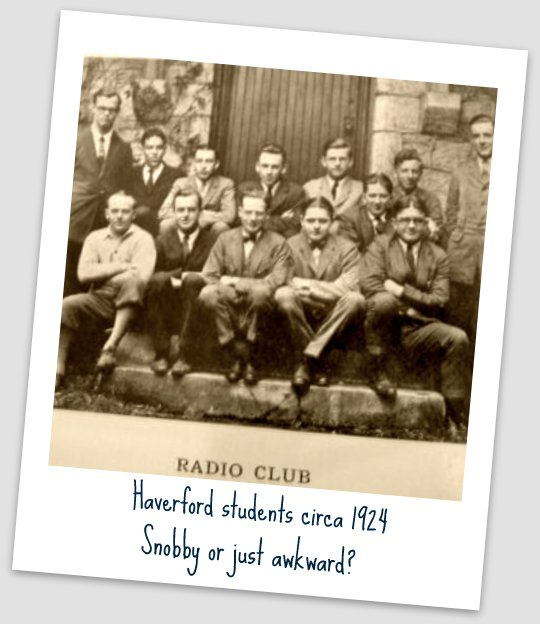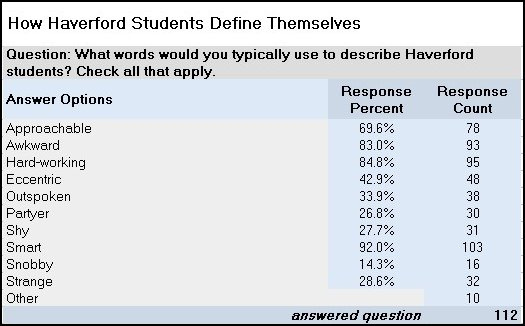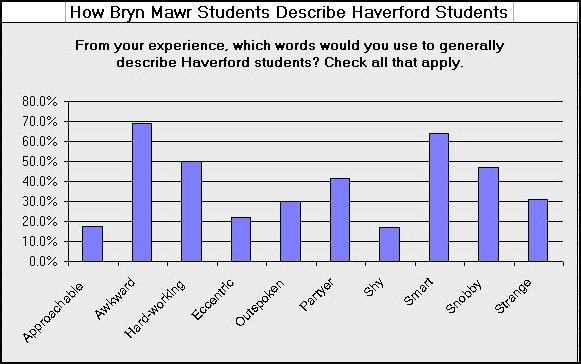For Haverford and Bryn Mawr students familiarity sometimes breeds contempt
By Hannah Turner
The relationship between Haverford and Bryn Mawr Colleges is advertised as “close”, “remarkable”, and “special” by both institutions.
Students can attend classes, eat, and socialize on both campuses, simultaneously getting a small college experience with the resources of a larger school. The liberal arts schools on Philadelphia’s Main Line are only two miles apart and have shared their “Bi-Co” relationship for decades.
Sounds wonderful, until you ask students at both schools what they think of each other.
Students at Bryn Mawr and Haverford readily admit that they have strong-and often negative-stereotypes about the students at the other school. 
In a series of interviews conducted on both campuses last fall, students used words such as awkward, weird, exclusive, crazy, and judgmental to describe students from the other campus. Clearly, there was some tension beneath the surface.
To test these attitudes, a survey was devised to measure what students at both schools thought of students on their own campus and the one two miles away. The email survey was sent in November. In all, 412 Bryn Mawr students and 133 Haverford students replied, a sizeable sample when taken together. Bryn Mawr is a Women’s College, so the majority of respondents were female.
The questions asked were identical on both surveys. Respondents were given a list of 10 attributes and asked to pick the ones that best described students at their campus and the other. The list, based on attributes mention most frequently in the earlier campus interviews, included: approachable, awkward, hardworking, eccentric, outspoken, partyer, shy, smart, snobby and strange. Respondents could also pick “Other” and room was given to type in additional comments..
The survey results revealed that students had strong and distinct opinions about each student body. To give the top responses, Haverford students saw themselves as smart (92 %), hard-working (85%) and awkward (83%), yet approachable (70%).
Bryn Mawr students saw themselves as hardworking (91%) and smart (87%), but added eccentric (67%) to the mix. However, as one Bryn Mawr respondent added, “This is a good thing!!”
In other words, students at both schools generally had high opinions of their brain power and work ethic. Next, the survey asked: “How would you describe students at the other school?” This is where the picture went negative.
Bryn Mawr respondents saw Haverford students as snobby (47%) but otherwise described their counterparts as Fords saw themselves-awkward (69%), smart (64%), and hardworking (50%).
Haverford students were not as kind, calling Bryn Mawr students strange (86%), eccentric (83%), awkward (74%), and outspoken (68%). Only 41 percent identified Bryn Mawr students as smart.
Here are explanations – taken from interviews with Bryn Mawr and Haverford students — about why they chose the attributes they did for themselves and for students at the other campus.
“Haver-awk”
Haverford students’ awkwardness came through in descriptions from both Bryn Mawr students and the Fords themselves. Bryn Mawr senior Sadie Marlow said Haverford students were “too smart and well educated that they’re not capable of being in a normal social setting.” It may sound harsh, but Haverford students actually agree.
Haverford freshman Joe Seiler described the awkwardness as “like, ‘Oh, we’re so awkward, that’s what sets us apart.’ But when we’re actually in awkward situations its like, ‘Oh, this is awkward, that’s not how we meant it’.”
Perhaps more eloquently, Haverford sophomore Kelly Lively described the awkwardness as discomfort in social situations.
 “Say you’re walking down the path,” she explained, “and you see someone you kind of know. There’s always a debate-should I say something? Should I not say something? And something always happens, you say ‘Hi’ at the same time or you run into each other or something. Whereas in the real world, you would just man up and say ‘Hi’.”
“Say you’re walking down the path,” she explained, “and you see someone you kind of know. There’s always a debate-should I say something? Should I not say something? And something always happens, you say ‘Hi’ at the same time or you run into each other or something. Whereas in the real world, you would just man up and say ‘Hi’.”
Haverford freshman Nick Trickett saw his classmates’ lack of social skills more optimistically. Trickett described the ubiquitous awkwardness as “just a different set of normal expectations because it’s such a small group of people.” At a large university social self-segregation is common. With just 1,200 students on campus though, Trickett explained, “you’re more likely to have people from different backgrounds interacting.”
Haverford sophomore Lucia Kearney said that at Haverford, it’s “like awkward is cool. Haverford’s [awkwardness] comes from realizing the awkwardness of the situations-thinking too much about things, but they can laugh at it.” On the other hand, Kearney said, Bryn Mawr students’ awkwardness comes from attempts to compensate for their insecurities.
Snobacracy
Although Haverford and Bryn Mawr students see eye-to-eye on Haverford’s awkwardness, nearly half of the Bryn Mawr respondents also called Fords “snobby” while only 15 percent of Haverford student characterized themselves that way. Many anonymous Bryn Mawr students said that Haverford students resist interaction with Bryn Mawr students, even in class. (Students could post comments on the survey without identifying themselves.)
Bryn Mawr freshman Fatema Esaa said she has met several nice Haverford students in class, but did remember getting “very snobby vibes” when meeting a group of the school’s freshmen during orientation week.
Snobby may be putting it nicely, though. One Bryn Mawr sophomore described Haverford students as “haughty.” She thinks that Haverford students feel superior because Haverford is co-ed, ranked better in U.S. News & World Reports college rangings, and supposedly more academically challenging.
Senior Melissa Schoeller, calling Haverford students exclusive and discriminating. “They always seem to isolate themselves and don’t let people from Bryn Mawr in,” Schoeller said.
However, when asked if Haverford students are snobby, freshman Max Reinhardt had a different spin on the situation. He said Haverford’s snobbery was based on a shared commitment to the school’s Honor Code.
Very Strange
The word eccentric was used by both groups to describe Bryn Mawr students, but the Haverford students (especially males) were more likely to call them strange. When asked if he thought Bryn Mawr students were eccentric, Seiler said, “That’s a way to put it. But I feel like eccentric, there’s something to it. Identifying as a dragon (as he had heard one Bryn Mawr student did) that’s just weird.”
Esaa said that “there are certainly eccentric [Bryn Mawr students], but,” she added, “it’s actually pretty difficult to generalize the Bryn Mawr woman, except for the fact that there’s a good chance she’s obsessed with Harry Potter.”
Trickett theorized that “a lot of the social eccentricism just comes from how they self-identify because they’ve actively put themselves in a [single-sex] environment that’s different from most other places.”
Still Haverford students also recognized that while there may be “strange” women at Bryn Mawr, there are plenty of normal ones too. Seiler explained that the reason Bryn Mawr gets its reputation is that “the strange ones are more prevalent than at other places, and more strange that at other places.”
Trickett and fellow Haverford freshman Jen Reeve agreed that Bryn Mawr and Haverford students are not inherently different. Bryn Mawr students may not agree with this, though. Senior Caitlin Schickel described Haverford students as “homogenous… especially in comparison to Bryn Mawr students…Haverford students are less likely to stand out from a crowd.”
While Bryn Mawr may hold its fair share of eccentricity, even in the dragon-identifying variety, Haverford is still seen as the boring sibling in the rivalry.
Thinking Outloud
Adding to Bryn Mawr’s stand-out nature is a lack of concern for what others think of them, said Haverford junior Robbie Thompson. Some call this opinionated. Others, like Bryn Mawr sophomore Erin Washburn, call it outspoken. In the survey. 60 percent of the Bryn Mawr respondents listed “outspoken” as one of the attributes that defined their student body, compared to 34 percent of Haverford students who described themselves that way.
Haverford senior Anastasia Nikolis explained that, on the spectrum of outspokenness, both student bodies are too extreme. “Haverford students can be quiet to a fault,” she said, “Bryn Mawr students are very ready to speak out, but sometimes speak too much.”
Trickett believes that Bryn Mawr students are not the only outspoken ones, though. Haverford students may be boring, but they do have things to say. The difference in outspokenness, Trickett said, is likely just a difference in preferred topics.
To the many Bi-Co students who primarily see their counterparts in classrooms, it seems like Bryn Mawr students are the only ones speaking their minds-or at least the only ones who get a chance. Haverford sophomore Carolina Arias explained that in Haverford classes there is a pause for thinking after a question is asked.
“At Bryn Mawr,” she said, “you immediately get someone trying to answer…they don’t have a filter.” Arias said she agrees with a professor’s claim that ‘Bryn Mawr students are out-spoken but not well-spoken.’
Still, much like with the strangeness, Haverford students recognize that there are many personalities at Bryn Mawr. Sophomore Maia Freudenberger said that she sees “a big divide between those [Bryn Mawr students] that are very shy and never speak up, and another group that is very talkative, very blunt and knows exactly what they want.”
It seems that both Haverford and Bryn Mawr students see themselves and their counterparts as both outspoken and timid. So much for that stereotype.
Stereotype Central
The attributes offered in the survey hit a nerve with Bi-Co students. Students knew what they thought of the others, and what the others thought of them. Answers to “Why are Haverford students awkward” and “Why are Bryn Mawr students eccentric” seemed almost rehearsed, confident and planned in defense of their own. Even freshmen, who comprised 21 percent of survey respondents, had plenty to say. But the questions remain: Where are these stereotypes coming from, and how are they engrained so quickly?
 One anonymous Bryn Mawr freshman said that “the tension between Haverford and Bryn Mawr is self-perpetuating…we’re indoctrinated with how weird the other school is and how awkward the encounters will be. It’s a self-fulfilling prophecy, and almost our own defense mechanism.”
One anonymous Bryn Mawr freshman said that “the tension between Haverford and Bryn Mawr is self-perpetuating…we’re indoctrinated with how weird the other school is and how awkward the encounters will be. It’s a self-fulfilling prophecy, and almost our own defense mechanism.”
Trickett had another theory. He said that even before orientation week had read about the Haverford/Bryn Mawr stereotypes online. From this research, Trickett felt aware of the fact that his orientation leaders were “being careful not to say anything bad about Bryn Mawr.”
Reeve and Seiler, too, said that their negative preconceptions of Bryn Mawr students predated their enrollment at Haverford. Lively said that she got her stereotype mostly from other people’s stories. Like 29 percent of Haverford’s survey respondents, neither Lively, Seiler, nor Reeve has ever taken a class at Bryn Mawr. And about 30 percent of Bryn Mawr students have never taken a class at Haverford.
Kearney, who has taken two classes at Bryn Mawr, said that “honestly I think these stereotypes get perpetuated because there’s a basis for them-it’s not like we make them up. And obviously things get blown out of proportion and you can’t just apply a label to an entire population, but the…people that do fit the stereotype are the ones that stand out.”
Ashamed to admit it?
Range of personalities or not, stereotypes of Bryn Mawr and Haverford students clearly run deep. However, most Haverford students profess to be unfazed by it. for their affiliation. Only five percent Haverford respondents said that they hesitated to identify as Haverford students while at Bryn Mawr.
In contrast, 24% of Bryn Mawr students said they hesitated to identify their school when they are at Haverford. .
As one Bryn Mawr freshman wrote in the comments section of the survey, she hesitated because “there seems to be a negative aura surrounding going to Bryn Mawr-the Bi-Co relationship seems lopsided, such that we need Haverford (so the straight girls on campus don’t go insane) but they don’t really gain anything from having us there. As such, it feels like being identified as a Mawrter automatically…characterizes one as desperate, [sexually] easy and overall a ‘lesser’ student because Haverford is also more prestigious on most widely-read ratings.”
Many respondents also voiced a belief that Haverford students withdraw from friendship when they find out someone goes to Bryn Mawr.
Some Haverford students feel that the judgment goes both ways, though. Kearney said that she “felt so ostracized in my Bryn Mawr class for being from Haverford… I feel like Bryn Mawr girls judge us more because of that feeling of inferiority, because Haverford is [statistically] a better school, that’s a fact. And they just have to live in close proximity to that.”
Can we be friends?
Both groups see themselves as smart and hard-working. Both groups see the other more negatively. When all is said and done, Bryn Mawr and Haverford students feel pigeonholed because the of the school they attend. It’s not a feeling that is likely to go away.
One anonymous Haverford junior felt that “Some Bryn Mawr students look down on Haverford women for not going to a women’s college.”
Trickett openly admitted that Haverford students judge Bryn Mawr students. However, he said, these judgments don’t apply to individuals, but rather when thinking of the Bryn Mawr population as a whole.
Kearney said that even though she knew she was being judged, she never hesitated to wear her bright red Haverford sweatshirt at Bryn Mawr. “I’m proud to go to Haverford,” she said, “I don’t want to hide that.” Esaa was equally proud of her affiliation, saying she felt sad that any of her classmates would hesitate to say they went to Bryn Mawr.
In some cases, the negative feelings may come down to misunderstanding. Bryn Mawr senior Rachel Wilson said that “Bryn Mawr women talk about Haverford women like they’re a different breed.” Wilson also claimed that Haverford’s co-ed student body gave its women a very different mentality than Bryn Mawr students.
When explaining the Haverford-Bryn Mawr relationship to a student from the North Carolina School of the Arts, a look of confusion washed over her face.
“Wait,’ she said, ” so you have classes and parties together but everyone just judges each other?”
Seeing the looks of confirmation on five Haverford students’ faces, the out-of-state student had only had one reaction: “Wow, that sucks.”
Software used: Survey Monkey. www.surveymonkey.com
